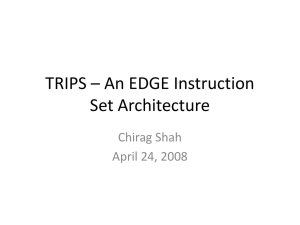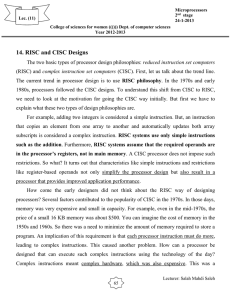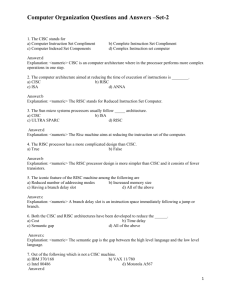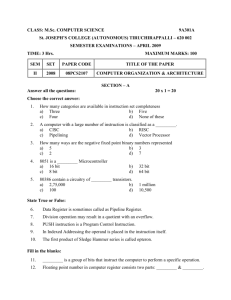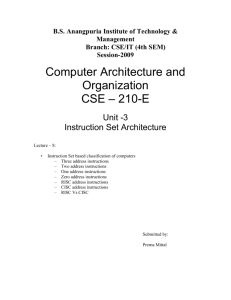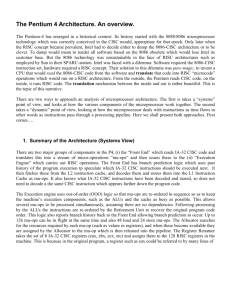Microprocessors 2 stage
advertisement
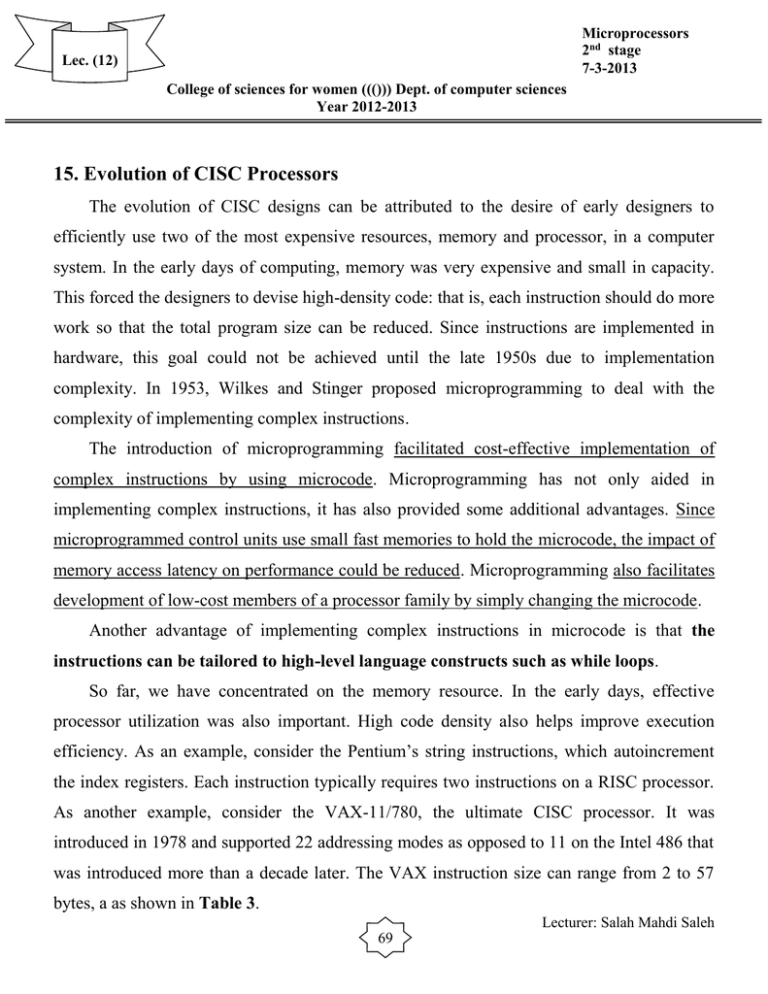
Microprocessors 2nd stage 7-3-2013 Lec. (12) College of sciences for women ((())) Dept. of computer sciences Year 2012-2013 15. Evolution of CISC Processors The evolution of CISC designs can be attributed to the desire of early designers to efficiently use two of the most expensive resources, memory and processor, in a computer system. In the early days of computing, memory was very expensive and small in capacity. This forced the designers to devise high-density code: that is, each instruction should do more work so that the total program size can be reduced. Since instructions are implemented in hardware, this goal could not be achieved until the late 1950s due to implementation complexity. In 1953, Wilkes and Stinger proposed microprogramming to deal with the complexity of implementing complex instructions. The introduction of microprogramming facilitated cost-effective implementation of complex instructions by using microcode. Microprogramming has not only aided in implementing complex instructions, it has also provided some additional advantages. Since microprogrammed control units use small fast memories to hold the microcode, the impact of memory access latency on performance could be reduced. Microprogramming also facilitates development of low-cost members of a processor family by simply changing the microcode. Another advantage of implementing complex instructions in microcode is that the instructions can be tailored to high-level language constructs such as while loops. So far, we have concentrated on the memory resource. In the early days, effective processor utilization was also important. High code density also helps improve execution efficiency. As an example, consider the Pentium’s string instructions, which autoincrement the index registers. Each instruction typically requires two instructions on a RISC processor. As another example, consider the VAX-11/780, the ultimate CISC processor. It was introduced in 1978 and supported 22 addressing modes as opposed to 11 on the Intel 486 that was introduced more than a decade later. The VAX instruction size can range from 2 to 57 bytes, a as shown in Table 3. Lecturer: Salah Mahdi Saleh 69 Table 3 Characteristics of some CISC and RISC processors To illustrate how code density affects execution efficiency, consider the autoincrement addressing mode of the VAX processor. In this addressing mode, a single instruction can read data from memory, add contents of a register to it, write back the result to the memory, and increment the memory pointer. Actions of this instruction are summarized below: (R2) = (R2)+ R3; R2 = R2+1 In this example, the R2 register holds the memory pointer. To implement this CISC instruction, we need four RISC instructions: R4 = (R2) ; load memory contents R4 = R4+R3 ; add contents of R3 (R2) = R4 ; store the result R2 = R2+1 ; increment memory address The CISC instruction, in general, executes faster than the four RISC instructions. That, of course, was the reason for designing complex instructions in the first place. Lecturer: Salah Mahdi Saleh 70 16. RISC Design Principles The best way to understand RISC is to treat it as a concept to design processors. Although initial RISC processors had fewer instructions compared to their CISC counterparts, the new generation of RISC processors has hundreds of instructions, some of which are as complex as the CISC instructions. It could be argued that such systems are really hybrids of CISC and RISC. In any case, there are certain principles that most RISC designs follow. Note that some of these characteristics are intertwined. For example, designing an instruction set in which each instruction takes only one clock cycle to execute demands register-based operands, which in turn suggests that we need a large number of registers. 16.1 Simple Operations The objective is to design simple instructions so that each can execute in one cycle. This property simplifies processor design. Note that a cycle is defined as the time required to fetch two operands from registers, perform an ALU operation, and store the result in a register. The advantage of simple instructions is that there is no need for microcode and operations can be hardwired. 16.2 Register-to-Register Operations A typical CISC instruction set includes not only register-to-register operations, but also register-to-memory and memory-to-memory operations. The Pentium, for instance, allows register-to-register as well as register-to-memory operations; it does not allow memory-tomemory operations. The VAX 11/780, on the other hand, allows memory-to-memory operations as well. RISC processors allow only special load and store operations to access memory. The rest of the operations work on a register-to-register basis. This feature simplifies instruction set design as it allows execution of instructions at a one-instruction-per-cycle rate. Restricting most instruction operands to registers also simplifies the control unit. Lecturer: Salah Mahdi Saleh 71 16.3 Simple Addressing Modes Simple addressing modes allow fast address computation of operands. Since RISC processors employ register-to-register instructions, most instructions use register-based addressing. Only the load and store instructions need a memory addressing mode. RISC processors provide very few addressing modes: often just one or two. They provide the basic register indirect addressing mode, often allowing a small displacement that is either relative or absolute. 16.4 Large Number of Registers Since RISC processors use register-to-register operations, we need to have a large number of registers. A large register set can provide ample opportunities for the compiler to optimize their usage. Another advantage with a large register set is that we can minimize the overhead associated with procedure calls and returns. 16.5 Fixed-Length, Simple Instruction Format RISC processors use fixed-length instructions. Variable-length instructions can cause implementation and execution inefficiencies. For example, we may not know if there is another word that needs to be fetched until we decode the first word. Along with fixed-length instruction size, RISC processors also use a simple instruction format. The boundaries of various fields in an instruction such as opcode and source operands are fixed. This allows for efficient decoding and scheduling of instructions. For example, both PowerPC and MIPS processors use six bits for opcode specification. It is worth mentioning at this point that the following set of common characteristics among RISC machines is observed: 1. Fixed-length instructions. 2. Limited number of instructions (128 or less). 3. Limited set of simple addressing modes (minimum of two: indexed and PC-relative). Lecturer: Salah Mahdi Saleh 72 4. All operations are performed on registers; no memory operations. 5. Only two memory operations: Load and Store. 6. Pipelined instruction execution. 7. Large number of general-purpose registers or the use of advanced compiler technology to optimize register usage. 8. One instruction per clock cycle. 9. Hardwired control unit design rather than microprogramming CISC features: 1-CISC processors use variable-length instructions to accommodate various complex addressing modes. 2-In CISC processors like the Pentium, operands can be in memory: Part of the reason for using variable length instructions is that CISC processors tend to provide complex addressing modes 3-A program (a software-based approach called microprogram control is used) is used to generate the control signals. 4-CISC processors such as the Pentium provide a wide variety of addressing modes Lecturer: Salah Mahdi Saleh 73
